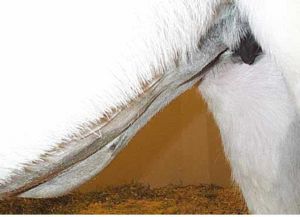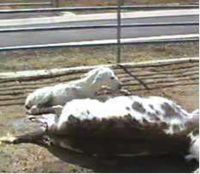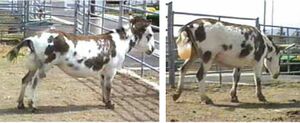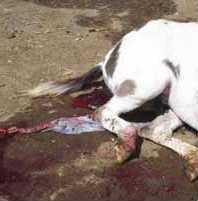Parturition - Donkey




The length of pregnancy is 365 to 376 days but extreme variations ranging from 340 to 395 days have been reported (Kohli et al, 1957; Tibary and Bakkoury, 1994; Macusoe et al, 2004). Male foetuses are carried on average one day longer.
Prediction of foaling is based on udder development and waxing, which seems to reliably start 24 to 48 hours before foaling. The calcium concentration in mammary secretions increases steadily in the last week of pregnancy and surpasses 500 ppm about 24 hours before foaling.
Parturition presents in the classical three stages:
- Stage 1: (preparation for labour) Characterized by increased restlessness, isolation from herd mates and frequent alternation between standing and lying down.
- Stage 2: (expulsion of the foetus) starts with the rupture of the allantochorion and appearance of the amniotic sac at the vulva. This is usually completed in 10 to 30 minutes with the female in lateral recumbency.
- Stage 3: (expulsion of placenta) usually completed in one hour but may take up to six hours. Possible retention of the placenta should be closely monitored and treated if the placenta is not passed by six hours. Treatment with oxytocin intravenously (in lactate ringer) or intramuscularly is effective. However, jennies with retained placenta should also be monitored for hypocalcaemia.
Parturition can be induced by the administration of small doses of oxytocin. Criteria for induction of parturition are similar to those described for the mare, that is, pregnancy length >340 days, evidence of mammary development and waxing, change in pre-colostrum electrolyte and no abnormalities (Pashen, 1980).
References
- Tibary, A., Sghiri, A. & Bakkoury, M. (2008) Reproduction In Svendsen, E.D., Duncan, J. and Hadrill, D. (2008) The Professional Handbook of the Donkey, 4th edition, Whittet Books, Chapter 17
- Kohli, M.L., Suri, K.R. (1957). ‘Studies on reproductive efficiency in donkey mares’. Indian J Vet. Sci. 27. pp 133-138.
- Kohli, M.L., Suri, K.R., and Chatter, J.I.A. (1957). ‘Studies on the gestation length and breeding age in donkey mares’. Indian Vet J. 34, pp 344-348.
- Mancuso, R., Torrisi, C., and Catone, G. (2004). ‘Experiences in the management of the reproductive activity of dairy jennie-ass’. Ippologia 15. pp 5-9.
- Pashen, R.L. (1980). ‘Low doses of oxytocin can induce foaling at term’. Eq. Vet. J. 12. pp 85-87.
- Tibary, A., Bakkoury, M.(eds). (1994). ‘Particularités de la reproduction chez les autres espèces équines’. Reproduction équine, Tome I: La jument. Actes Editions 1994. pp 385-400.
Literature Search
Use these links to find recent scientific publications via CAB Abstracts (log in required unless accessing from a subscribing organisation).
Donkey Parturition related publications
|
|
This page was sponsored and content provided by THE DONKEY SANCTUARY |
|---|
